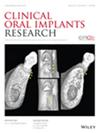One-Piece Versus Two-Piece Abutments for Single Crowns in the Esthetic Zone: A Clinical Trial
Abstract
Objective
To evaluate whether a two-piece abutment is equivalent to a one-piece in peri-implant esthetics, patients' satisfaction, and oral health–related quality of life (OHRQOL) for implant-supported anterior single crown placement.
Material and Methods
Thirty implants were allocated sequentially: 15 in the one-piece abutment group (OP) and 15 in the two-piece abutment group (TP). Peri-implant esthetics were evaluated by the pink esthetic score (PES) at temporary crown insertion (T1), after tissue conditioning (T2), and at 30 days after the final crown insertion (T3). OHRQOL was measured using the OHIP-14 and satisfaction was evaluated using the visual analog scale (VAS) at baseline, T1, and T3. Treatment was considered equivalent if the 95% coefficient interval (CI) for mean difference in PES was between −1.5 and +1.5 points. Statistical analysis was performed using Mann–Whitney, SPANOVA, and Student's t-test, with Sidak's posttest, adopting p < 0.05.
Results
No differences were found between the groups for any variable and during follow-up. A significant increase in OHRQOL and satisfaction was observed at T3, when compared to baseline (p < 0.05) for both groups. Significant improvements in peri-implant esthetics were also observed throughout the treatment, particularly after tissue conditioning (p < 0.05). Primary and secondary outcomes were evaluated for equivalence, and both abutment types were considered equivalent following the insertion of the temporary crowns.
Conclusions
Two-piece abutment was equivalent to one-piece abutment for peri-implant esthetics, quality of life, or the satisfaction of patients rehabilitated with metal-free single crowns. Tissue conditioning and final crown insertion appear to play a role in improving these outcomes.

 求助内容:
求助内容: 应助结果提醒方式:
应助结果提醒方式:


